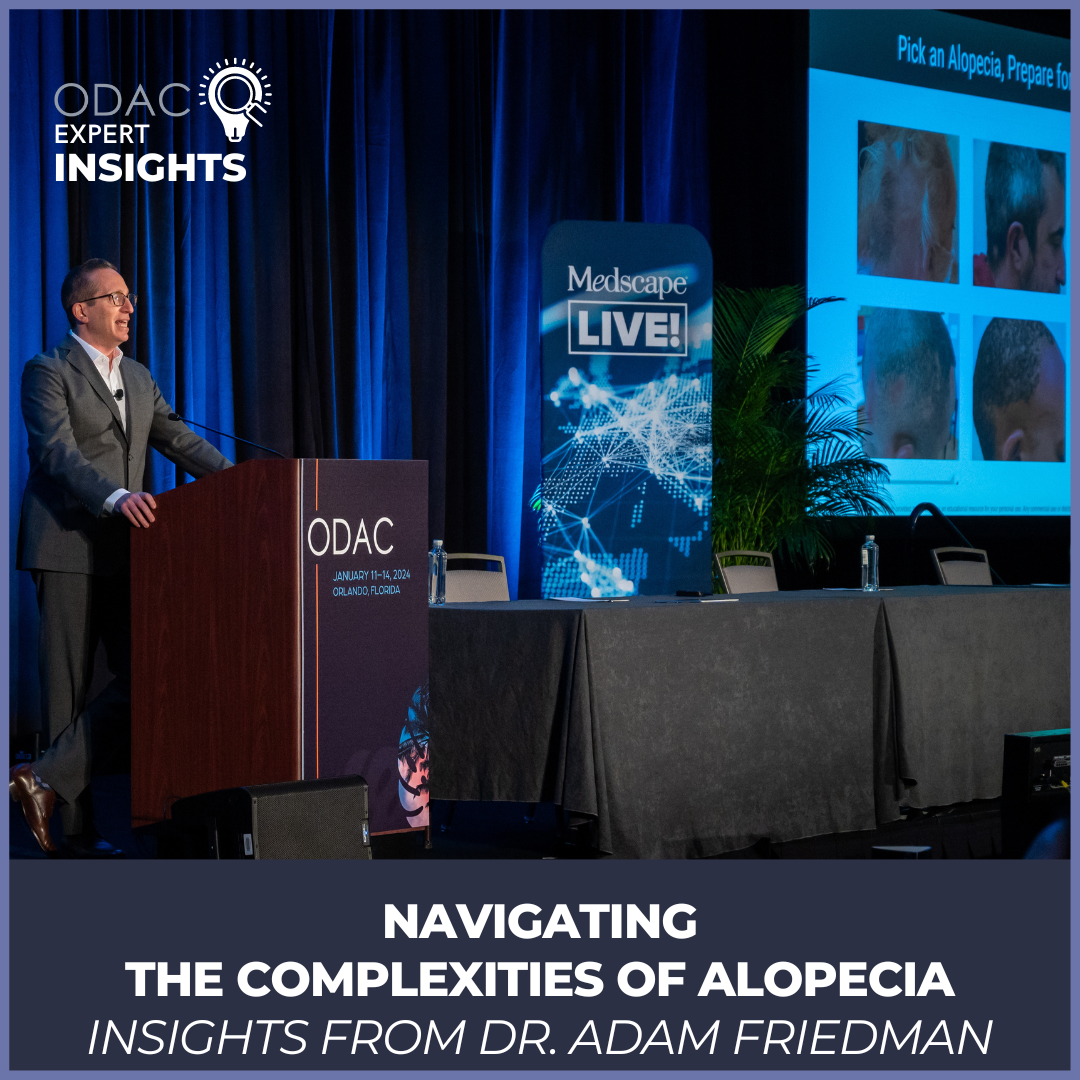Dr. Adam Friedman’s lecture at 2024 ODAC conference provided invaluable insights into the nuanced approach required when dealing with patients presenting with alopecia. Addressing the diverse array of alopecia types and their myriad presentations, Dr. Friedman emphasized the significance of a comprehensive clinical history and evaluation to formulate an effective treatment plan. By employing a case-based methodology, he skillfully demonstrated the importance of thorough patient assessment, highlighting key questions and examination techniques essential for accurate diagnosis and management. Read on for all his practical pearls!
Dr. Friedman began his talk by asking the audience how often patients come in with their own alopecia diagnosis and with a request for a specific treatment. There are many different types of alopecia that patients may be suffering from, and it is important to take a complete and full clinical history and evaluation of patients when they present to clinic. He then used a case-based approach to walk the audience through how he approaches patients.
Case 1 HPI
A 52-year old woman presents with a complaint of hair loss. She has noted increased shedding of hair in the shower and around her home. She has a strong family history of hair loss (her two brothers and mother). Her father has an autoimmune condition. She has attempted over the counter shampoo indicated for “increased hair thickening” with no help.
When first interviewing the patient, it is imperative to start off simple to further understand their hair loss. A few initial questions to ask:
-
- Is your hair shedding?
- Is your hair breaking?
- Is your hair thinning?
Patients may be suffering from many symptoms and from a combination of different types of alopecia. For example, this patient below is suffering from both androgenic alopecia and alopecia areata.

Other important questions to ask patients include:
-
- How long ago?
- Scalp or other body areas as well?
- Gradual or sudden onset?
- Patches or diffuse?
- How did the patients first notice their hair loss – was it while in the shower
- Did their hairdresser point it out to them?
- Approximately how much (percentage) of their hair has been lost?
- Any associated symptoms like itching, scaling, redness, or pain?
- Are they suffering from any excess hair elsewhere?
Personal medical history assessment should include assessment of autoimmune/inflammatory conditions and history of cancer. Medication history should include old and new medications and timeframe. It is possible that a medication may be contributing to a patient’s hair loss. Female and male patients should be asked about hormonal therapies like oral contraceptives, hormonal replacement, like testosterone, for men. Family history should extend beyond nuclear family hair loss, age of onset and recovery in patients’ father, brother, mother, sisters, and children hair loss should be ascertained. Family history of cancers, autoimmune and inflammatory diseases like thyroid, diabetes, vitiligo, celiac, inflammatory bowel, rheumatoid arthritis, lupus should additionally be assessed. Lifestyle factors like vitamins, supplements (DHEA, retinoids), diet (crash, vegan, weight loss), and exercise habits (marathon training) should additionally be asked. A patient who experiences a dramatic weight loss or increased volume of exercise may experience hair loss due to these physical stressors.
Physical examination of the scalp should include dividing hair into smaller sections to assess redness, scale, pustules, and bald patches. Feeling for hair density and evaluating the scalp thoroughly is not only important for diagnostic purposes, but they also help the patient feel thoroughly evaluated. A hair pull test should be performed, however, it is important to ask if the patient washed their hair the morning of their exam, as hair washing up to 24-48 hours prior to examination may result in a false negative test. Patient’s facial and body hair, including eyebrows, eyelashes, should be assessed for increased or decreased hair present since conditions like alopecia areata can convert to either alopecia totalis or alopecia universalis. Nails findings, like beau’s lines and onychomadesis, can be indicative of alopecia areata or telogen effluvium.
Dr. Friedman reserves biopsies for questionable diagnoses, patient request, and/or mixed pictures. He reminds practitioners that biopsies should only be used if they change diagnoses. Do not biopsy an evolved or established scar in scarring alopecias. Laboratory work up can be helpful, especially if patients request. Remember to keep in mind laboratory cues/alopecia associations: patchy alopecia of syphilis, anemia, thyroid disease, hormonal imbalances or deficiencies. Do not test hormones near ovulation (during menstrual period or week prior is best) and at least 6-weeks post OCP cessation (patient must not be on OCP).
There are two overarching types of alopecia: non-scarring and scarring (cicatricial). Non-Scarring includes:
-
- Androgenic Alopecia
- Alopecia Areata
- Telogen Effluvium
- Seborrheic Dermatitis
- Trichotillomania
- Traction Alopecia
- Psoriatic Alopecia
- Tinea Capitis
- Presure Alopecia
Scarring (cicatricial) includes:
-
- Fibrosing Alopecia in Patterned Distribution
- Frontal Fibrosing Alopecia
- Central Centrifugal Cicatricial Alopecia (CCCA)
- Discoid Lupus
- Folliculitis Decalvans
- Dissecting Cellulitis
Dermoscopy can be very helpful in determining the difference between follicular crop out versus preservation, which is especially important for diagnosis. Dermoscopy can also help provide and temper patient expectations about hair growth over time.
Lastly, it is extremely important to be patient with these patients. Many will be tearful and for many, the dermatologist is their last resort after many treatment methods.
This information was presented by Dr. Adam Friedman during the 2024 ODAC conference. The above highlights from his lecture were written and compiled by Dr. Surya Veerabagu.
Did you enjoy this article? You can find more on Medical Dermatology here.

